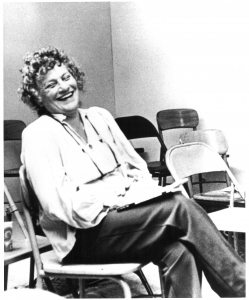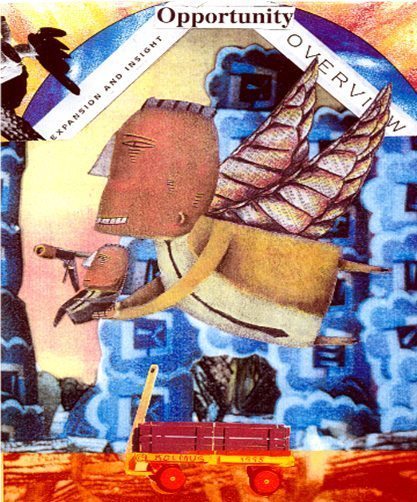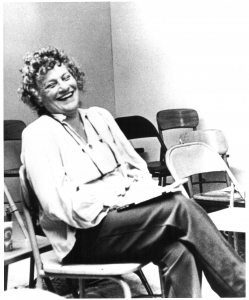Becoming Part of the Whole contrasted with Yes, and…
Improvisation today concerns itself with connection, but it is mostly a connection of common ideas and shared references. Yes, and… is not wholly without merit, for in many cases collaboration of this sort can produce unexpected outcomes and does bring unity to groups, but it is limited by its reliance on intellect, and initiation of ideas to build on rather than exploring a shared experience.
The Source
Viola Spolin’s seminal work “Improvisation for the Theater” is considered by many the bible of Improvisation. It is the first training system for teaching improvisation in the United States. As a philosophy and pedagogy, it is comprehensive and, in the words of one truly inspired player, Severn Darden, “It is vast.” It wasn’t until I began working with other improv groups who used other techniques developed at places like The Second City, The Groundlings, Upright Citizen’s Brigade, Theatre Sports and Improv Olympic did I come across the phrase “Yes, And…” as a foundational improv concept.
I have always had a nagging feeling about Yes, and… and its relationship to the work of Viola Spolin. Nowhere in her written work do I find this explicit concept of Yes, and…, yet it has become the governing pillar of Improvisation the world over.
But if Yes, and… is the bedrock of improvisation, why didn’t Viola Spolin include it as a basic concept in her very thorough training system for scene improvisation? This is, I think, a pivotal question.
In my opinion, it marks a fork in the road in the evolution of Improvisation as we know it today and a diversion from Viola Spolin’s notion of Improvisation.
 The Path to Scene Improvisation: Becoming Part of a Whole
The Path to Scene Improvisation: Becoming Part of a Whole
In looking through Viola Spolin’s book, the only game concept that resembles Yes, and… is her Part of a Whole series. The first exercise in the series is Orientation #1 or Adding a Part to a Whole: where one player goes on stage and becomes a part of a larger object. Each player in turn joins by adding another part until all are part of a larger whole. This is sometimes called “Machine”, but players could become part of a painting, a car, or any inanimate object.
The idea of Yes, and… is implicit in this because group agreement is required and each player must add to it.
She follows this with the rest of the Part of Whole series #2, 3 & 4.
In Part of a Whole #2 Activity, the initial player picks a simple activity and begins doing it. Other players come on stage one at a time and join in the activity. The focus is on ‘showing the activity’. This group activity creates flow and energy – or should. She suggests you repeat the game until this happens.
Part of a Whole #3 is the same, but the focus changes from activity to occupation. An example is first player washes her hands, stands waiting with hands in the air, second player enters as a nurse and helps the doctor put on surgical gloves. Other players enter to become anesthesiologist, patient, intern, etc. We begin to see the Where.
Part of a Whole #4 focuses on communicating Who (relationship) by showing and not telling. Example: man hangs a picture; woman enters saying she would like it a little higher. Man may accept her as a wife or gallery owner, other players enter with actions to show who they are. Spolin states that this game will bring forth the first signs of a scene, emerging from the focus.
This progression introduces players to the idea of adding to by showing (not telling, i.e., verbalization) where they are, who they are and what they are doing. It is the Who, What and Where – that is the foundation of Spolin’s scene improvisation. Implicit in these activities is the idea of accepting and adding to or Yes, and… In my experience, wherever I have seen Yes, and… employed in many improv workshops it is almost always verbal (telling) in favor of setting up a cast of characters that can begin to co-create a story. The story being the focus. It leaves out a vital element (showing) Spolin’s Part of a Whole. Showing Who, What and Where will set up the same thing only non-verbally, allowing a scene to emerge.
I agree that Yes, and… is an easily grasped way to ask the player to accept the situation and build on it. Also, it is a good way to get over the habit of denial: the urge for the timid or fearful player to reject an idea or premise in order to introduce a ‘better’ idea or at least ‘his/her idea’ for a scene. But I think that starting with saying “Yes, and…” became a short cut to develop material for a story by verbally introducing ideas, which brings us to…
The Fork in the Road
Since the introduction and widespread adoption of Yes, and… Improvisation instruction and practice took a different path from Spolin. It has devolved to a blunted comedic form, or at best, a theater of ideas without much theatricality. It fosters a way to connect mainly through labelling and intellect (what Spolin called ‘the head’) rather than showing the relationships and space and rarely ventures into the unknown but simply a device to invite an exploration of story and character.
Spolin was always moving towards the joyful spontaneous explosion when you go beyond the game. When you heighten and explore you invite the possibility of going beyond that of the known into new areas. It can only be done by always seeking to become part of a larger whole and not just through Yes, and…

Thanks, Gary – I’ve enjoyed reading this in conjunction with your follow-the-follower post. I’m curious as to how the divergence toward “yes, and” occurred, and also how it became viewed as the underlying philosophy of so much improvisation.
My two cents, for what it’s worth, is this. I’ve completed training in a “yes, and…” model, and I’ve also completed training in Viola’s work.
The “yes, and…” approach feels “easier.” I’m not sure I really felt challenged, and I definitely never broke a sweat. The end goal seemed to be performance for the value of performance. Now, I enjoyed it, and felt good when something I said got a laugh, but it was quite different than Spolin games.
Viola’s approach challenged me, in a very positive way, and yeah, I was out of breath after some exercises. And, while I think some pretty great scenes came out of sessions I’ve been in, there was also very clearly growth that occurred, within and between each session.
Sidecoaching had a lot to do with that – “Show, don’t tell,” “No playwrighting,” “Follow the follower…” All take steps beyond – and from this post, I can see, steps distinct from – a “yes, and” framework.
There’s a reason I keep coming back to Spolin sessions.
Really enjoyed your posts on the ‘yes, and…’ model, Gary. In addition to the issue with telling instead of showing, I think ‘yes, and…’ can be a bit of a mental concept of acceptance, instead of honest, total acceptance of a situation (which always includes the self) and building upon it. It also leads to planning, instead of discovery, and in my experience, planned scenes always lack life.
One instance I can recall where the ‘yes, and..’ mode was challenged was when I played ‘It Feels Like…’ (which I think is a truer derivative of Viola’s work). My partner said something about how she felt I was, and I instinctively denied it. I remember my brain going into overdrive for about a second with red flags because in a basic ‘yes, and…’ model, I could’ve killed the scene. But then I realized the exercise was about both my partner and I giving and receiving honestly, and only from that place of truth could the who, what, where emerge. And when it did, it was fantastic and beyond anything either of us could’ve planned. Moreover, we didn’t have to try to accept the situation or perform a scene; we were IN the scene. The ‘yes, ands’ were automatic and at a much deeper level.
That’s a great story, Janna. Experience is the teacher. Information should flow from that and not vise versa.
Gary, I often have had the sense that ‘Yes, and… ‘ can sometimes seem forced in a scene. Like you say, it’s often story-focused, and, in-the-head. More talk than action. I wish to explore some of Spolin’s approaches. I want to experiment with how I can incorporate Part of a Whole into a virtual online setting, for instance.
Love it, Gary!
“Yes, And…” can be a great tool for avoiding feeling real emotions and authentic connection, can’t it…?! As a teacher of yoga and meditation — as well as improv — I find (attachment to) the fear of feeling one’s feelings to be, perhaps, the most prevalent and powerful impediment to students’ growth. So many of us will plateau, or simply give up, because we haven’t learned how to navigate this primal emotion.
Thank you Gary for directing us toward your observations…
It seems for me, realizing that I can neither be solely responsible for the joyful, magical whole nor removed from the process, is a great source of aliveness and oneness with others.
The sound of silence brings for me a smiley joy!